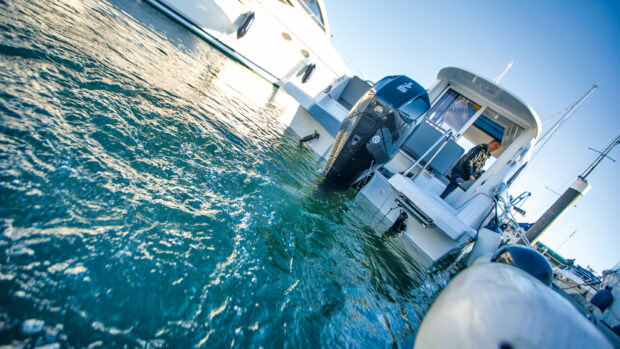Whether you call it antifoul or bottom paint, a good layer of hull protection is vital to stop your boat from getting covered in marine life. Our resident boating instructor Jon Mendez explains how it's done...
Contrary to many boat owners, antifouling is one of my favourite off-season jobs. If done well, it will ensure you get a full season’s boating with very little fouling and minimal loss of performance or fuel economy – even a small amount of fouling can increase fuel use by 20% or more.
Most (but not all) antifoulings are toxic to certain forms of marine life but they can also be harmful to humans, so you will need personal protective equipment before starting.
How to antifoul: Equipment
At a minimum I’d suggest overalls, gloves, a face mask and a hat and goggles for working under the boat, but make sure you read the paint tin and hazard sheets for further guidance.
Most boatyards pressure-wash the bottom of the boat for you when they lift it. This will remove most of the growth from the hull, props and drives but make sure you wash off any barnacles or slime they may have missed, especially in awkward to reach areas such as bow thruster tunnels and behind chines.
Our test boat came out reasonably clean and simply needed a good scrape with a sharp-edged scraper around the waterline to remove irregularities from the previous year’s antifoul, followed by some 40-grade sandpaper to key the surface for the new paint.
Article continues below…

The big antifouling test 2023: The full results of our 18-month showdown

Hempel Silic One: Is this the future of antifouling?
This is the moment when the mask and goggles are very important, due to the dust it produces. You need to be extra thorough around rough patches of old paint or areas that may have been missed, such as where the lift’s slings or support chocks were.
If the previous layer of antifouling has started to lift or flake off, you will need to scrape it right back to the gelcoat and key and prime it again. Lastly, rinse off any areas you have sanded and allow it to dry properly.
The next task is to mask off the waterline, so as to leave a nice clean edge, and around any metal outdrives or outboard mountings, taking care to leave a 1in gap between the paint and the metal to prevent the copper compounds in the antifouling causing galvanic corrosion of the aluminium alloy.
How to antifoul: Method
Before applying the antifouling, I leave the pots upside down for 30 minutes so that all the heavier active ingredients aren’t stuck at the bottom, then give it a really good stir for 5-10 minutes, making sure the stirrer reaches right to the bottom of the pot. I also re-stir it each time I fill the paint tray.
I find that a small paint roller with a high-density foam head is best for the main underwater sections as it gives me more control than a large roller but is still quicker, smoother and gives a more even thickness than a brush.
However, I use a brush for greater accuracy along the waterline (working away from the edge of the tape), around the hull fittings and along the inside edge of the chines.
Unless the boat is huge, I go around the whole waterline first, working down to the first chine, then complete the hull underneath, by which time the paint around the waterline is dry enough for its second coat.
A good even coat that hasn’t been rollered out too thinly is essential. The tin will say what the coverage should be so use it exactly as recommended – don’t skimp.
Most advise at least two coats (antifoulings are designed to wear away gradually over time to reveal fresh biocide beneath) but I often add an extra coat around the waterline and other areas of high wear.
I like to lift the tape off after coat one to check that I have a good edge before applying more tape for coat two. This is also a good time to ask the boatyard to reposition the support chocks so you can fill in any areas that you couldn’t get to during the first coat, although some yards prefer to touch these in when they lift the boat for re-launch.
Once complete, and having used up any paint left in the tray, I dispose of the brushes and roller heads safely, then go about removing the waterline tape.
My sneaky tip here is to pull the tape from the end you started taping with first so that all the overlaps are picked up and you end up with one continuous piece that you can roll into a ball, then tuck into the centre of your glove as you remove it ready for convenient disposal.
If you enjoyed this…
Be first to all the latest boats, gadgets, cruising ideas, buying advice and readers’ adventures with a subscription to Motor Boat & Yachting. Available in both print and digital formats, our monthly magazine will be sent directly to your home or device at a substantial discount to the usual cover price. See our latest offers and save at least 30% off the cover price.










